How to Memorize Music:
A Comprehensive Guide for Lasting Memory

"Douglas who?"
Douglas Niedt is a successful concert and recording artist and highly respected master classical guitar teacher with 50 years of teaching experience. He is Associate Professor of Music (retired), at the Conservatory of Music and Dance, University of Missouri-Kansas City and a Fellow of the Henry W. Bloch School of Management—Regnier Institute for Entrepreneurship and Innovation.
Doug studied with such diverse masters as Andrés Segovia, Pepe Romero, Christopher Parkening, Narciso Yepes, Oscar Ghiglia, and Jorge Morel. Therefore, Doug provides solutions for you from a variety of perspectives and schools of thought.
He gives accurate, reliable advice that has been tested in performance on the concert stage that will work for you at home.
PURCHASE AN ALL-ACCESS PASS
TO THE VAULT OF CLASSICAL GUITAR TECHNIQUE TIPS

"Hello Mr Niedt,
My name's Gretchen, and I'm so happy I purchased an All-Access Pass to the Vault. I love your awesome technique tips. I'm amazed how much I have improved my playing.
Thank you!"
ARE YOU LOOKING FOR PROVEN STRATEGIES
THAT WILL MAKE YOU A BETTER GUITARIST?
Check out the game-changing tips in my Vault—I promise they will kick your playing up to the next level.
Purchase an All-Access Pass to the Vault.
It's a one-time purchase of only $36!
You receive full access to:
- Over 180 technique tips in The Vault.
- Special arrangements of Christmas music
- Arrangement of the beautiful Celtic song, Skellig
- Comprehensive guide, How to Master the Classical Guitar Tremolo
All that for a one-time payment of only $36. Take me to the page to Purchase an All-Access Pass
How to Memorize Music:
A Comprehensive Guide for Lasting Memory
By Douglas Niedt
Copyright Douglas Niedt. All Rights Reserved.
This article may be reprinted, but please be considerate and give credit to Douglas Niedt.
This is a comprehensive article. It's long! Approximate reading time is 40 minutes but it's worth it.
Below is a mindmap summarizing this article. It will give you an easy-to-understand overview of the material before you dive in.
CLICK ON THE IMAGE TO ENLARGE.
Download a handy, printable PDF of this chart!

WHY SHOULD YOU MEMORIZE A PIECE OF MUSIC?
Performing from memory is an exhilarating, freeing experience because you are not tied to an external page in front of you. Memorizing a piece of music offers numerous benefits for guitarists, enhancing both their performance and overall musicianship. Here are some key reasons to memorize music:
- Enhanced Performance Confidence:
- ♫ Freedom from Sheet Music: Without the need to constantly read from a score, guitarists can focus more on their technique, expression, and connection with the audience.
- ♫ Reduced Mistakes: Relying on memory can sometimes reduce errors associated with reading notation under performance pressure.
- Improved Musicality:
- ♫ Deeper Understanding: Memorizing music involves a deeper analysis of the piece, leading to a better understanding of its structure, harmonies, and phrasing.
- ♫ Expressive Playing: Guitarists are more likely to play the music expressively when not tied to the sheet music, allowing for more natural and fluid interpretations.
- Technical Mastery:
- ♫ Muscle Memory: Memorization helps develop muscle memory, making technical passages smoother and more consistent.
- ♫ Focus on Technique: With the notes memorized, players can concentrate more on their technique, ensuring their playing is technically sound.
- Mental and Cognitive Benefits:
- ♫ Memory Skills: Memorizing music enhances cognitive abilities and memory skills, which are beneficial both within and outside musical contexts.
- ♫ Concentration: Memorizing music requires intense concentration and focus, which can improve overall mental discipline.
- Professional Expectations:
- ♫ Performance Standards: In many professional and competitive settings, guitarists are often expected to perform from memory, especially in solo repertoire.
- Auditions and Competitions:
- ♫ Memorization is frequently a requirement for auditions and competitions, demonstrating the guitarist's commitment and preparedness.
By memorizing a piece of music, guitarists can achieve greater technical precision, emotional depth, and overall confidence, leading to more compelling and successful performances.
WHEN SHOULD I START MEMORIZING A PIECE?
It is a good idea to begin memorizing early in the learning process. You do not want to master the piece and then start all over to memorize it. However, do not start memorizing until you finalize all your fingerings and are positive you are playing all the notes and rhythms correctly. You do NOT want to memorize errors.
Under no circumstances should you ever begin memorizing a piece a month or less before a performance.
PACE YOURSELF. TAKE IT SLOWLY.
Memorization is an intensive process. TAKE BREAKS. TAKE SMALL STEPS. Unless you are very skilled, do not try to memorize an entire piece, even if it's short, in one day. Depending on the length and complexity of the piece, it will take several days or weeks to memorize it.
Having said that, try to work on your memorization several times throughout the day. Research shows that spacing out your memorization practice throughout the day significantly improves long-term retention. However, it is also a fact that people's concentration and focus vary throughout the day. Some people are morning people, some are night people, and some lose focus in the afternoon. Take this into account because the process of memorizing a piece requires intense focus.
Note that as you work on your memorization, you will spend a significant amount of time NOT playing the guitar. Some of the work will be listening, singing, and practicing the piece in your head. You will also spend many hours analyzing the piece, recognizing patterns and relationships, finding facts, and making connections between those elements.
You will use mental practice to hear the piece in your head and play it in your head. You can engage in mental practice with your eyes closed, staring at an object, or staring off into the distance. You can do it anywhere: in bed, sitting quietly indoors or outdoors, walking, waiting for an appointment, etc. WARNING: DO NOT DO MENTAL PRACTICE WHILE DRIVING or OPERATING MACHINERY because it uses your total focus; you will zone out and become unaware of your surroundings.
PRELIMINARY STEPS
You need to do three things before you begin actively memorizing a piece:
Preliminary Step #1: Listen to the piece dozens of times.
Before you start memorizing the piece, it's crucial to listen to it dozens of times. Ask your teacher to record it for you. Listen to other professionals play it. If there are recordings of several musicians performing your piece, try to listen to all of them. Or, if you already know the piece and can play it with the music, record it yourself and use that as your model for listening.
Follow the score as you listen. Listen to the piece dozens (and I mean dozens!) of times over several days or weeks. Repeated listening will internalize the music in your body and brain, making it easier to memorize.
Listening while watching the score helps you create a clear "sound image" in your brain, making the notes on the page come to life. Repeated listening strengthens the sound image, forming a deep connection between the sounds in your head and what they look like on the printed page. That connection speeds up the memorization process, making the notes no longer an abstract entity on the page.
Preliminary Step #2: Know the basic layout of the piece and map out a plan for memorizing it.
Find where phrases and sections begin, end, or return. Find contrasting phrases and sections. Familiarizing yourself with the song's structure makes memorizing it much more efficient. Knowing where the sections are will help you establish goals and map out a plan for memorizing the piece. For example, it is usually best to memorize the most complex sections of a piece first rather than starting at the beginning. They can be the most challenging to memorize and benefit from early, focused practice.
Preliminary Step #3: Learn to sing the piece.
Learn to sing the piece all the way through. To memorize a piece, you must know "how it goes." For most pieces, that means knowing the melody well enough to sing it by memory while out for a stroll. For contrapuntal pieces, it means being able to sing the individual voices.
Can't sing? You don't have to be Pavarotti or Taylor Swift. What you sound like doesn't matter. If you never sing or are not used to singing, it may take a while to become comfortable with it. Lock yourself in a room and wail away! The ability to sing the piece is crucial to memorization and retaining that memorization over many years.
Some pieces are more conducive to singing than others. For example, singing the melody of the famous anonymous Romance is much easier than singing the upper voice of an entire Bach fugue.
If you are memorizing a simple Sor or Carulli study, sing the melody (usually the notes with the note stems pointing upward). If you are trying to memorize a Bach fugue or other contrapuntal piece, you will want to learn to sing each individual voice. To learn how to identify the voices in a piece, see this technique tip.
The most challenging music to sing and memorize is contrapuntal (polyphonic) music and "New Music" (avant-garde, experimental music, musique concrète instrumentale, Spectralism, New Complexity, New Conceptualism).
Regardless of which voice you are trying to learn to sing, learn small units. Learn to sing small chunks, then chain the chunks together into larger units. The chunk could be a measure or an entire phrase. Just as in physical guitar practice, use the chaining or chunking strategy:
- Learn chunk A, learn chunk B, and then sing chunk A+B.
- Learn chunk C.
- ♫ Sing chunk B+C.
- ♫ Sing chunk A+B+C.
- Learn chunk D.
- ♫ Sing chunk C+D.
- ♫ Sing chunk A+B+C+D.
- When the chain breaks, review the weak chunks. Then, link them back together.
In addition to “chunking,” use these four strategies to learn to sing your piece. You don't have to do it in this order.
- ♫ Sing with the recording and watch the score.
- ♫ Sing with the recording without watching the score.
- ♫ Sing without the recording but watch the score (give yourself the starting pitch).
- ♫ Sing without the recording and no score (give yourself the starting pitch).
Remember, don't overwhelm yourself. Take breaks. Learn to sing small chunks. You can use different approaches on different days. Mix it up.
For more information on learning how to sing your pieces, read my technique tip.
USE FOUR TYPES OF MEMORY TO MEMORIZE YOUR PIECE
The four types of memory are:
- Visual memory. Visual memory is remembering the patterns and shapes we see on the fretboard. (As a footnote, for a few gifted individuals, visual memory can refer to seeing the music on the page. But that ability is relatively rare and will not be discussed here.)
- Intellectual memory. Intellectual memory is recognizing and remembering patterns, facts, relationships, and connections.
- Aural memory. Aural memory is remembering the sound of the piece in your head. Ideally, the performer should be able to hear the piece in their head from beginning to end. However, being able to sing the piece is also an acceptable form of aural memory.
- Tactile or muscle memory. Tactile or muscle memory refers to the fingers remembering what to do independently without help from visual, aural, or intellectual cues. Most guitarists rely primarily on tactile memory, but unfortunately, it is the first to fail under performance stress. Violist and neuroscience expert Molly Gebrian calls this implicit or procedural memory and explains that it does not require conscious awareness. She writes, "Your enduring ability to ride a bike, even if you have not done so for many years, is because of implicit memory. Most likely, you cannot explain very well how to ride a bike—you just know how to do it."
Try to develop all four types of memory. If one memory type should fail, the others will kick in to prevent a memory slip. For most people, one of the four memory types will be stronger than the others. But we want to make all four memory types equally strong, not only to have a backup in case one fails but also because they all reinforce each other. Many guitarists rely too much on tactile or muscle memory. Unfortunately, it is usually the first to fail under performance stress.
You can successfully memorize a piece without using all four types of memory. However, the fewer types of memory you employ, the greater the chance of your memory failing, especially under stress.
Intellectual and Visual Memory: Recognizing Patterns and Relationships, Using Facts, and Making Connections
Visual memory is closely allied with intellectual memory because visually, we remember patterns, shapes, and chords we see on the fretboard. But our brain automatically assigns meanings or names to these elements. For example, if our fingers hold a D7 chord, our brain automatically registers it as a triangle shape or, if we know our chords, a D7 chord.
Since visual and intellectual memory tend to act as a single entity, my following explanations will flip-flop between both.
Elaborative Processing
Playing a measure or phrase mechanically over and over (rote practice) will help you memorize a piece. That type of practice primarily develops tactile or muscle memory. However, a much more effective method of memorization uses "elaborative processing." Elaborative processing involves relating the music to associated facts, concepts, ideas, and relevant knowledge. Some writers call this explicit, semantic memory. You will memorize faster when you recognize patterns and relationships, use facts, and make connections. But more importantly, you will remember what you memorized for a longer time. It will "stick" better.
As the Bulletproof Musician notes, Researchers have long recognized that identifying patterns and structure is a critical ingredient in being better at memorization. Great memorizers don't necessarily have inherently better memory but are more effective at identifying patterns and structure among the notes on the page and fretboard. Making connections to patterns, facts, and relationships is a primary factor in cementing our memory so that memorization "sticks" over days, weeks, months, and years.
Prerequisites to Using Elaborative Processing to Improve Your Intellectual and Visual Memory
You don't have to be a whiz at music theory, but to make and see musical connections, relationships, and patterns more easily, it is beneficial to:
- Know all the notes on the fretboard. See my Ultimate Fretboard Trainer.
- Recognize chord shapes.
- Know the notes and structure of most chords.
- Be familiar with intervals, especially 3rds, 6ths, and 10ths. See my technique tips about intervals. This is Part 1. This is Part 2.
- Understand that groups of measures form phrases and groups of phrases form sections.
STEP #1. HOW TO DEVELOP YOUR VISUAL AND INTELLECTUAL MEMORY USING ELABORATIVE PROCESSING
The visual component of memorization requires you to look at the left hand most of the time. Some people get confused looking at their left hand. You must get past that. Visual fretboard memory is powerful and very important.
What PATTERNS should you look for, and what strategies should you use to help you memorize a passage using your visual and intellectual memory?
- Right-hand patterns.
- Many classical guitar pieces contain arpeggio patterns that are easy to memorize with a little rote practice.
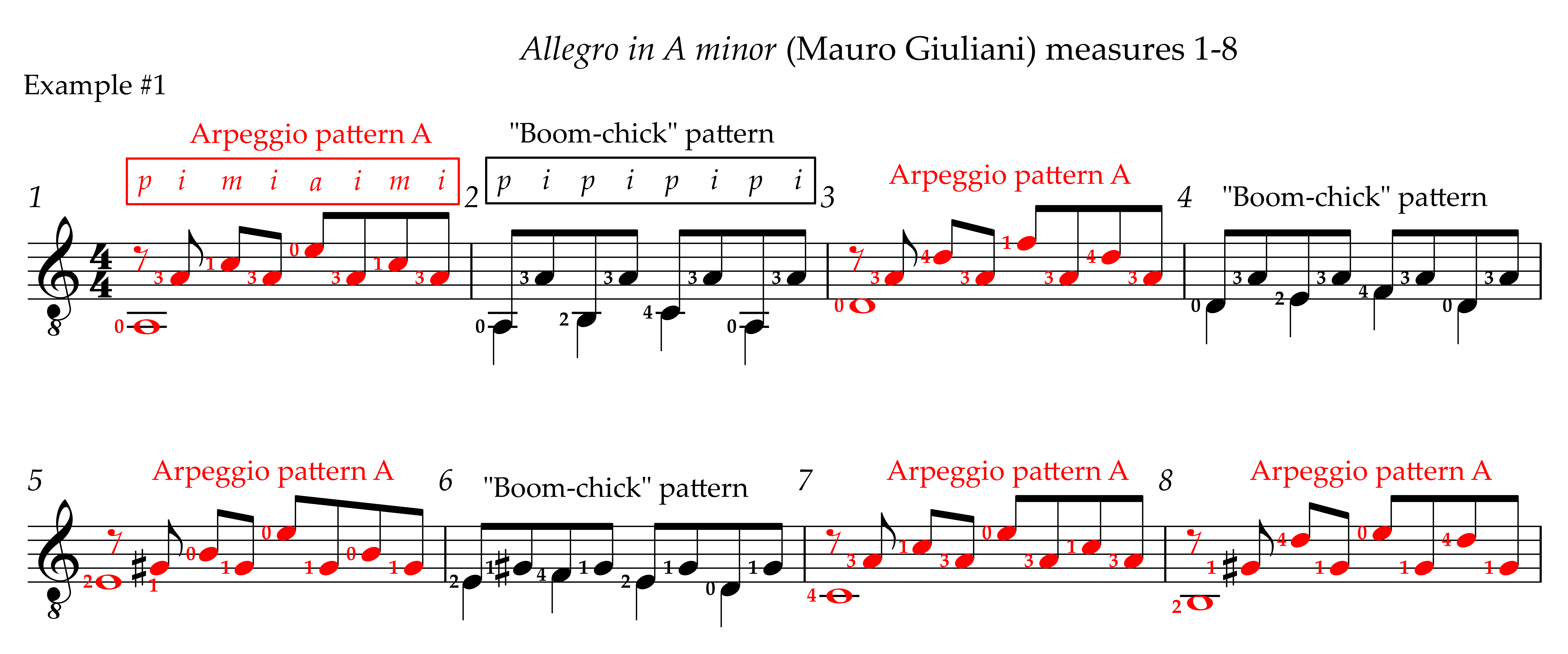
- Look for patterns with repeated right-hand finger sequences.
- Look for passages that use i-m or i-a finger alternation. They will be easy to memorize, but you must remember which finger starts the pattern.
- Look for bass lines that move in a pattern. Many bass lines alternate between two strings.
- Look for a rhythmic pattern. The bass line or melody might be a repeated rhythm.
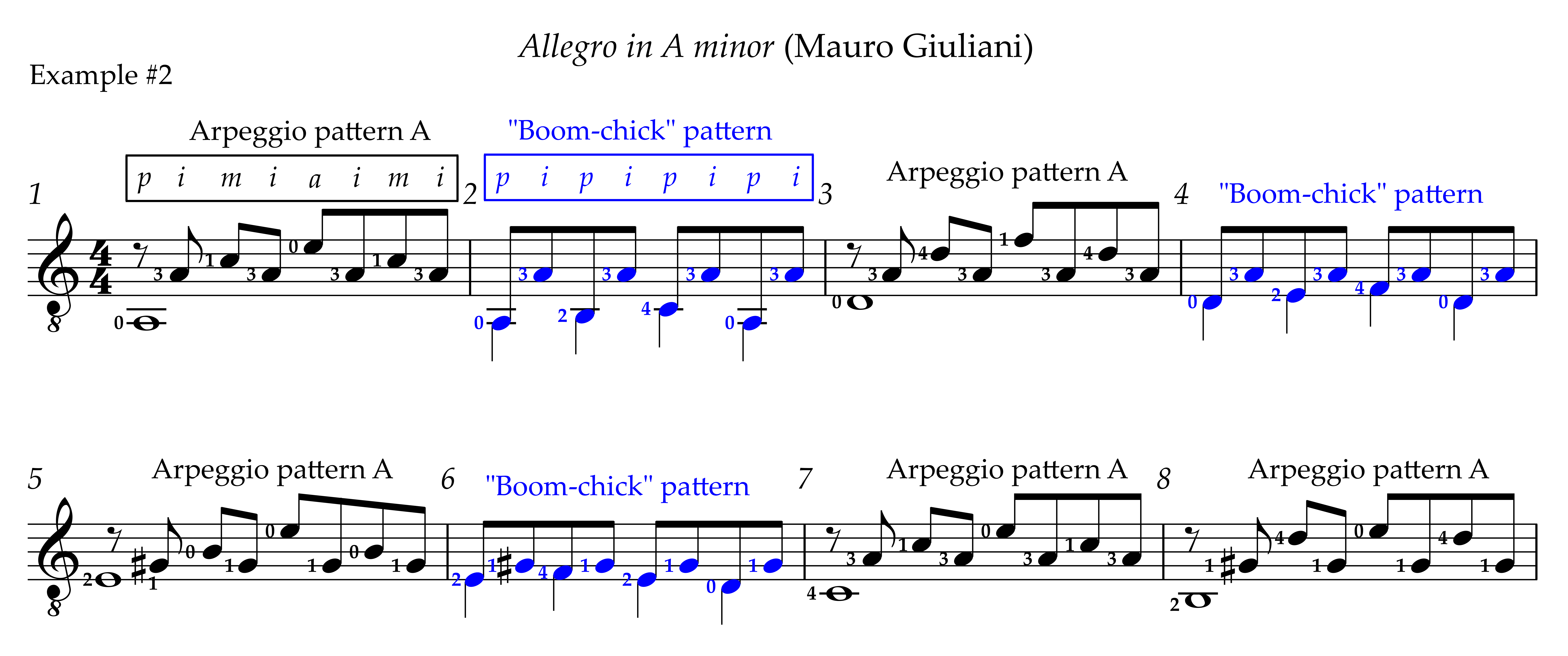
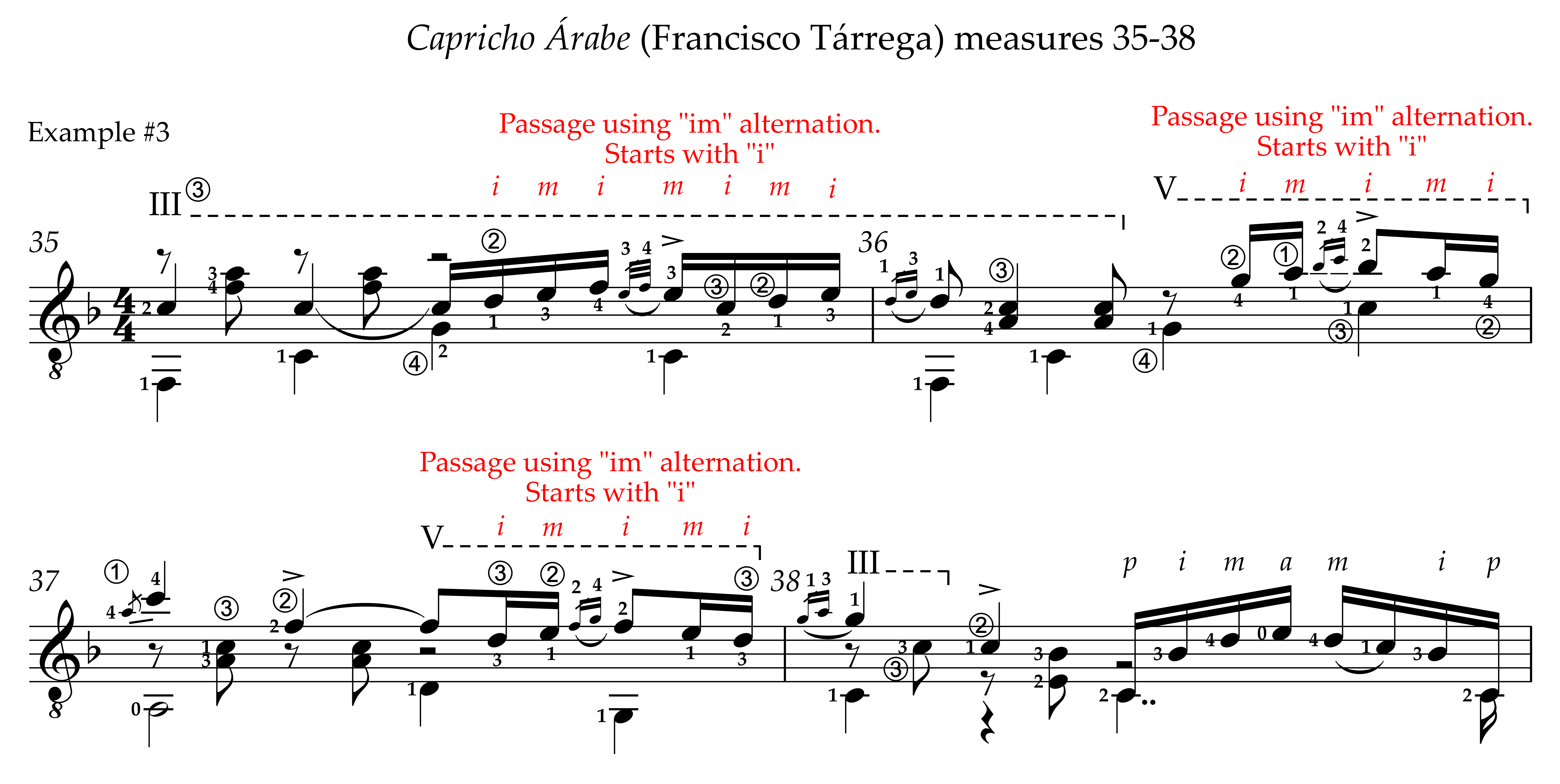
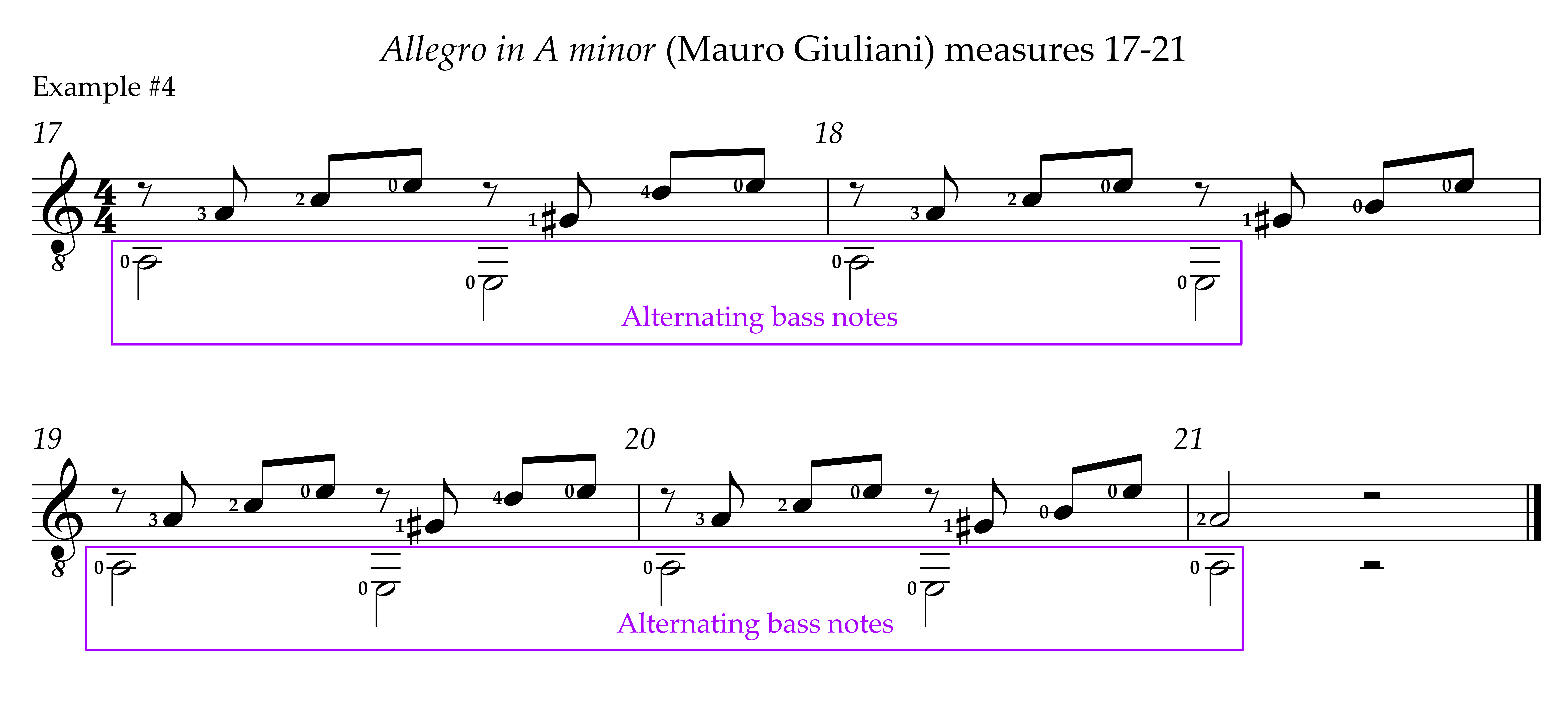
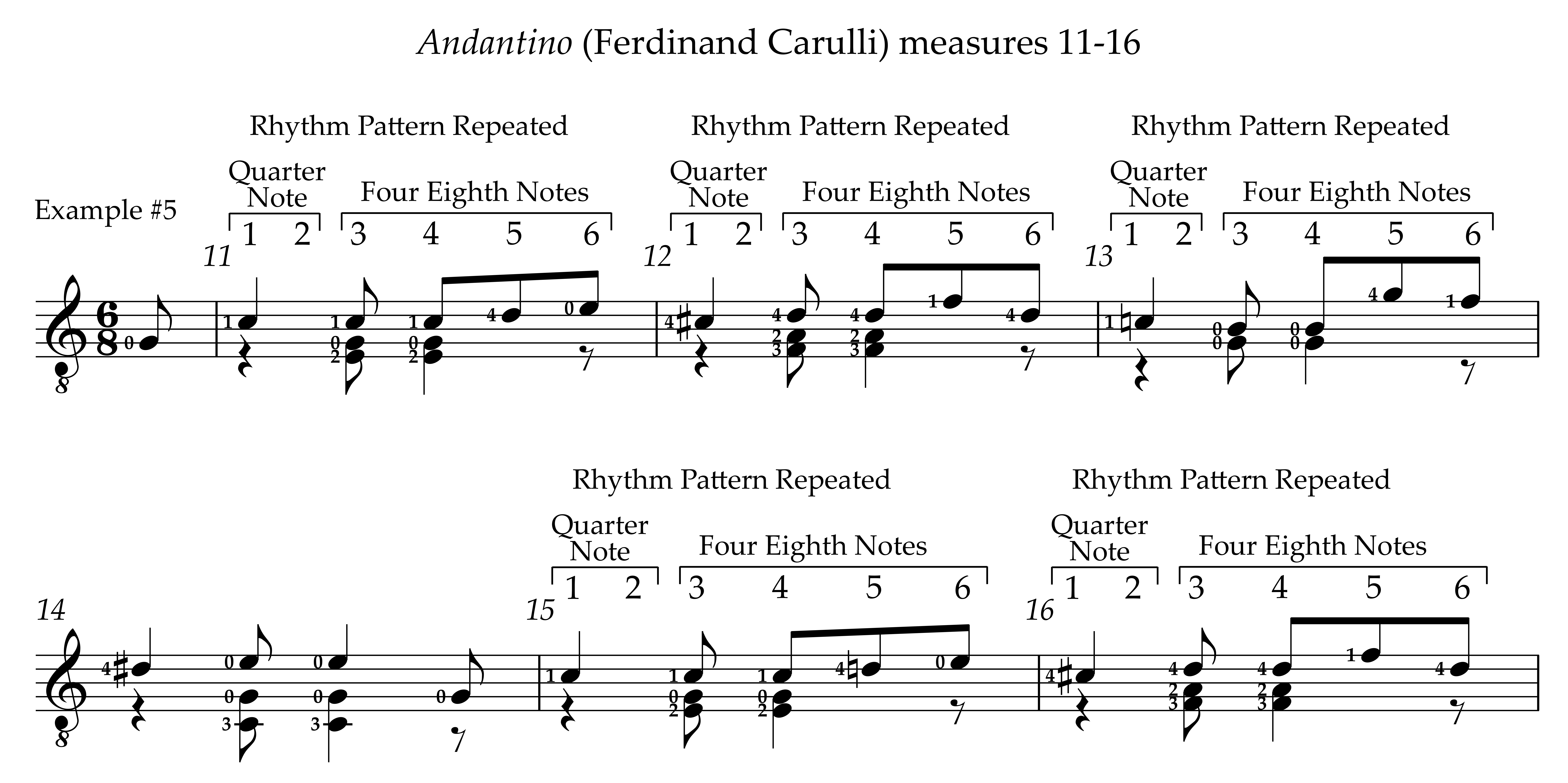
- Many classical guitar pieces contain arpeggio patterns that are easy to memorize with a little rote practice.
- Left-hand patterns.
- Look at chord progressions. A chord progression might follow an easy-to-remember sequence that spells a word. For example, the progression could spell B-A-D. Or if you know basic music theory, you might recognize a typical pattern such as I, IV, V7, I.
- Look for repeated chord sequences.
- Look for easily recognizable finger configurations (finger shapes and spacings).
- Look for repeated fingering sequences.
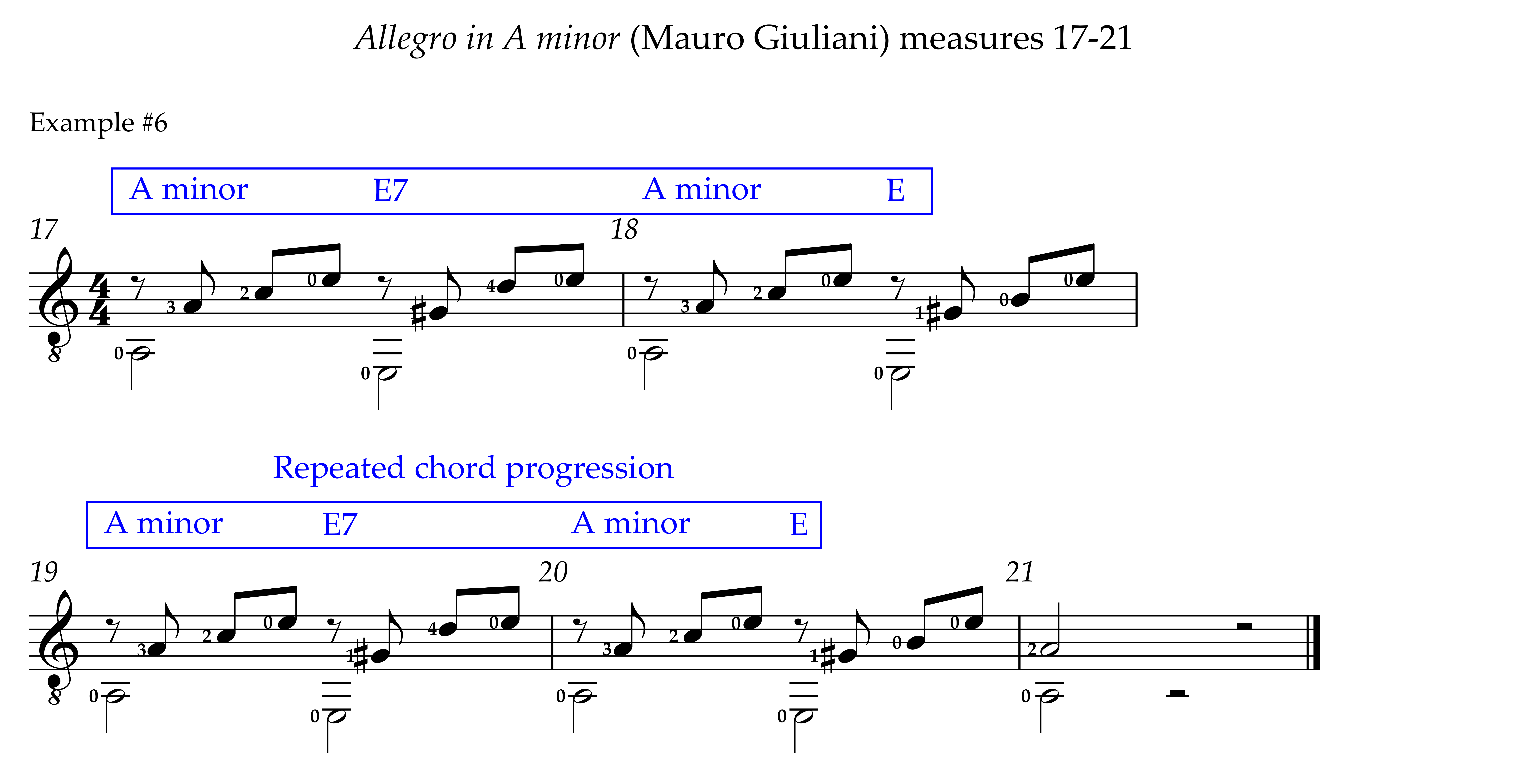

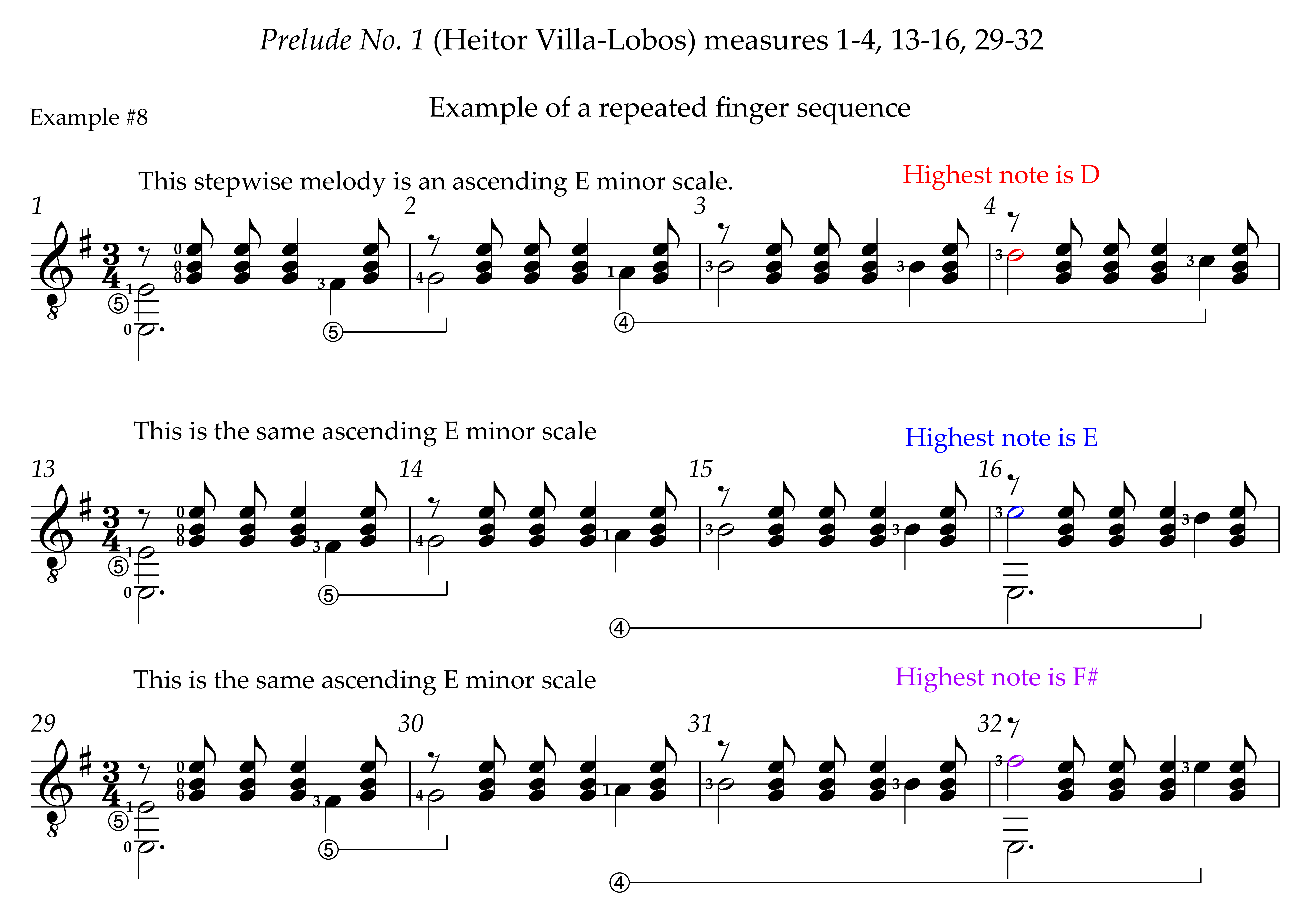
- Repeated sections.
- Look for sections that are literal repeats.
- Look for repeated passages with slight alterations.
- Look for repeated passages with significant alterations but still recognizable as using the same musical material, configurations, or fingerings.
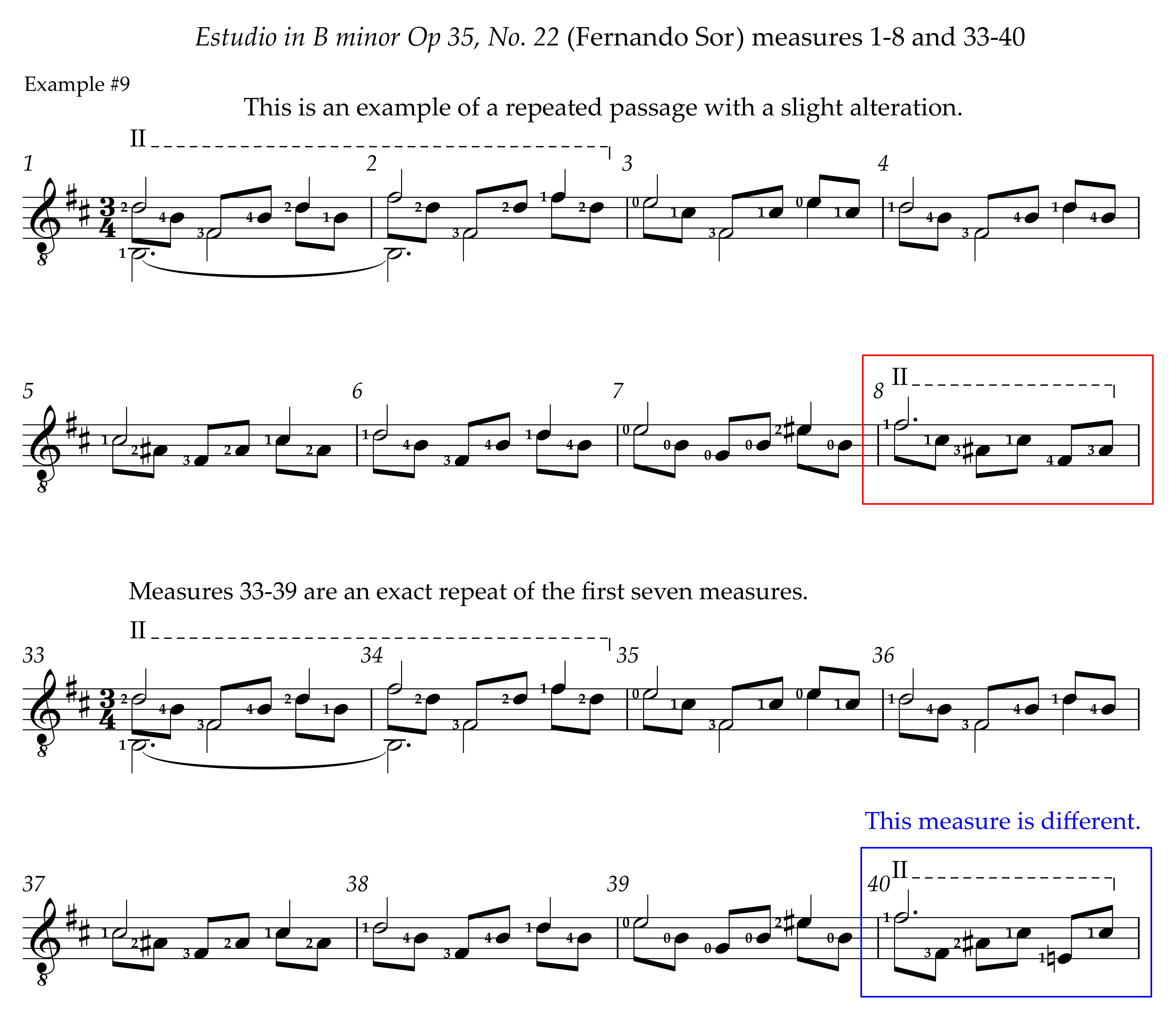
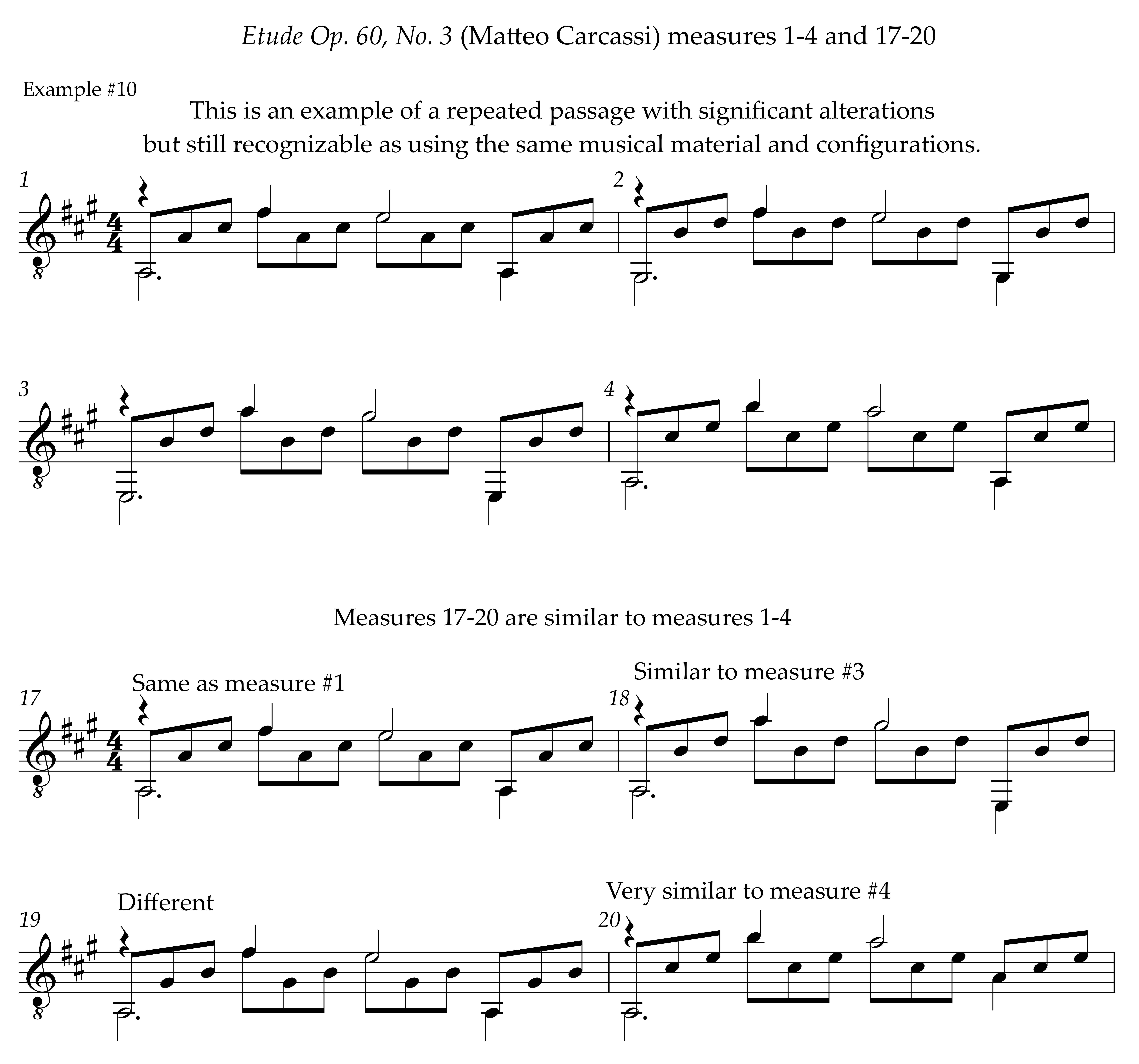
- Use mnemonic devices.
- Acronyms are easy to use when memorizing music. For example, a chord or note progression of D-A-D spells "dad." Research says that the sillier or nonsensical the thought or acronym, the better. For example, in Villa-Lobos' Prelude No. 3, the melody notes of the chord progression in measures 16-17 are D-D-E-D-C-B-C-D. You could use the acronym Daring Dogs Eat Delicious Chocolate Before Chasing Ducks to remember it.
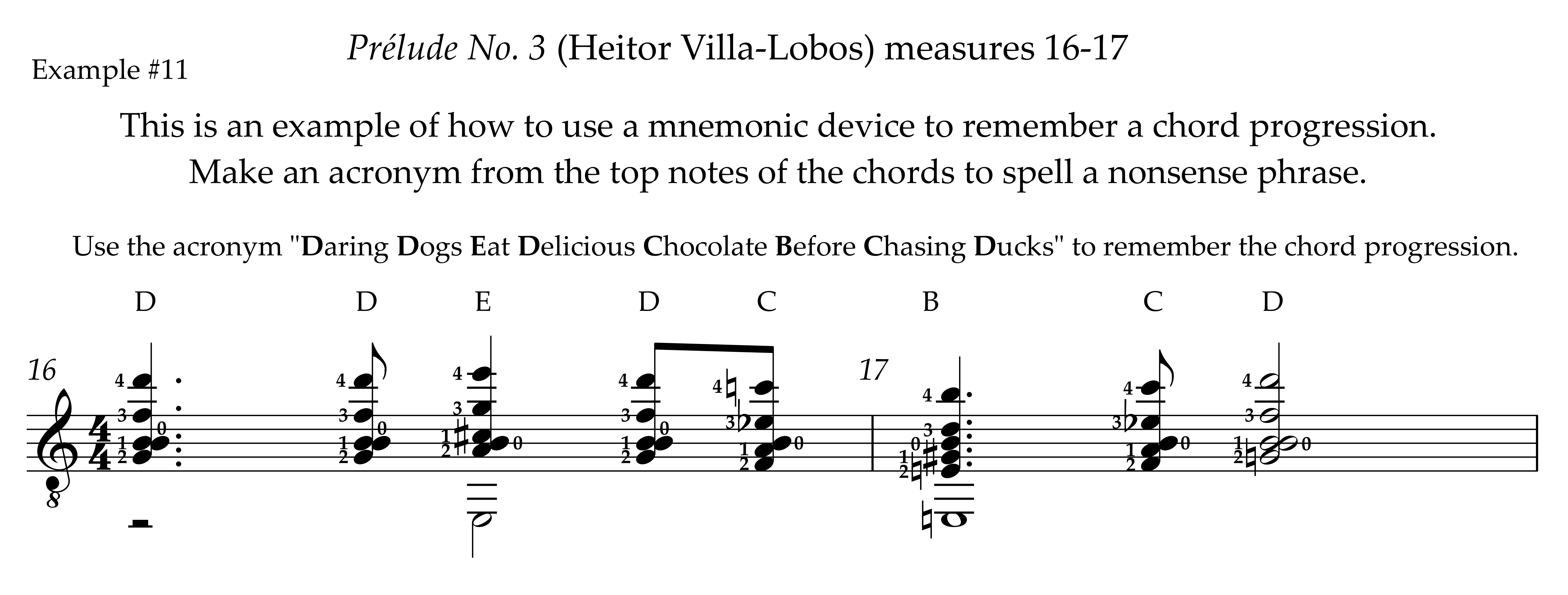
- Scale patterns.
- Look for scale-based note progressions. For example, we might see that a melody starts on the 1st-string open E and descends as a natural E minor scale to the 4th-string E.

- Interval patterns.
- A passage might ascend or descend in thirds, 6ths, 10ths, or octaves. Or, they could ascend or descend in broken intervals.
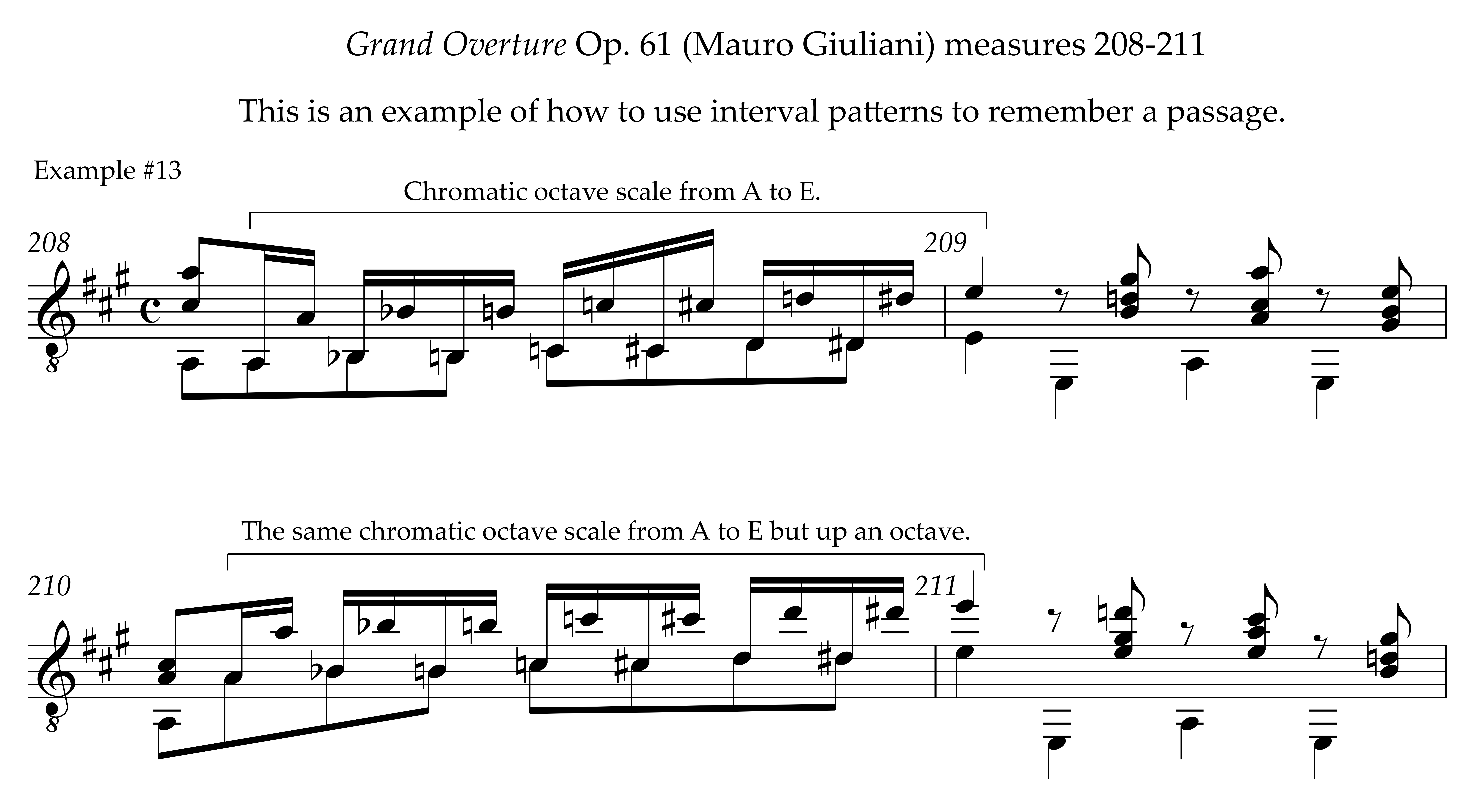
- Rhythmic patterns.
- Look for rhythmic patterns in the melody, bass, and inner voices.
- The structure of a piece or section of a piece is often based on a repeated rhythmic pattern. For example, in 3/4 time, the pattern could be half note-quarter note/half note quarter note that repeats for several measures.
- Frequently, the bass line will be repeated or contain a particular repeated rhythm.
- Even the harmony might change in some rhythmic pattern.
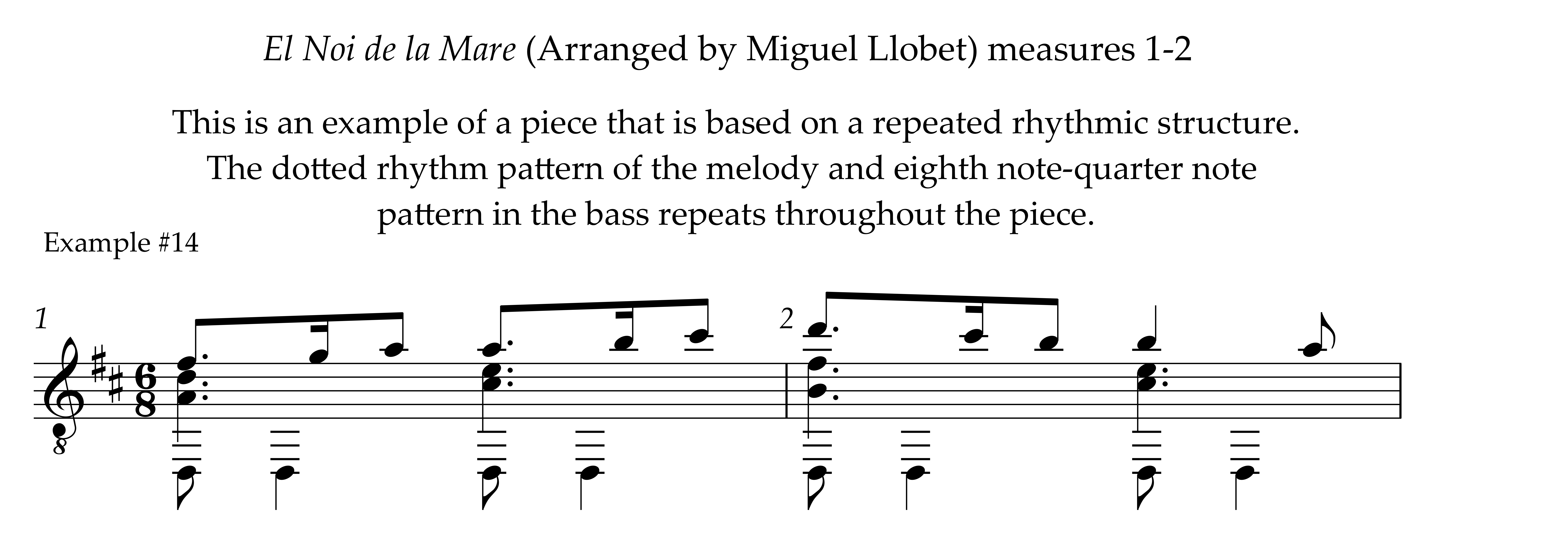

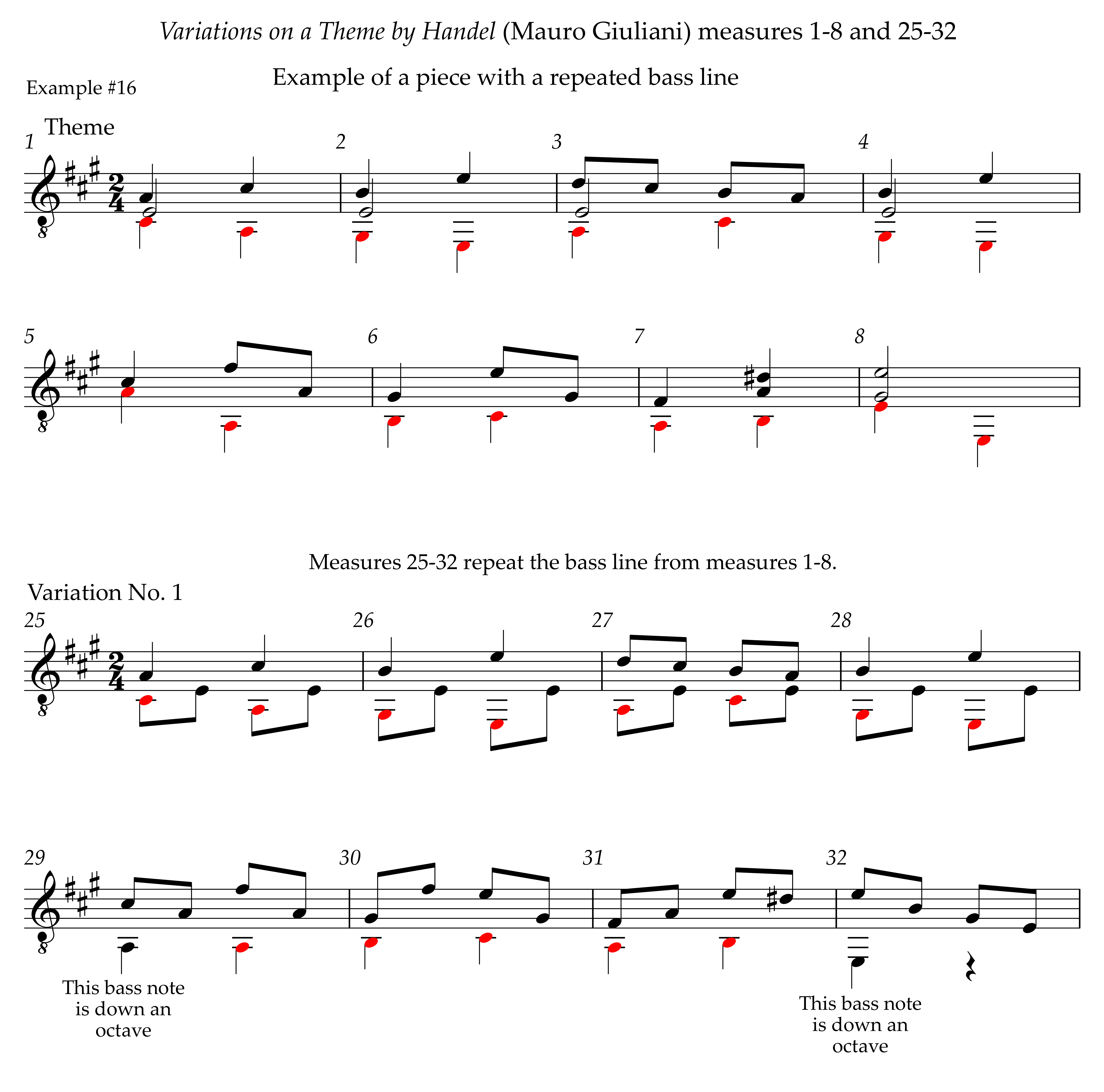
What FACTS should you look for to help you memorize a passage?
- Chord names. Knowing the names of chords is one of the most robust aids to memorization. Every chord has a set group of notes it may contain. Every chord has specific recognizable shapes on the fretboard. However, a chord in your piece will not always include every one of its notes. But if you thoroughly know your chords and the notes they contain, you can also easily recognize fragments of chords.
- Left-hand finger shapes. Recognizing finger shapes is the same as recognizing chords, except we may not know the name of the chord or can't associate it with a particular chord name. For example, we may be holding a basic D7 chord and see it as a triangle shape but not know it is called a D7 chord. Or, we might remember, "Oh. I have my 1st, 2nd, and 3rd fingers all at the 2nd fret spaced a string apart." Or, "For this chord change, I need to switch my 1st and 3rd fingers from the 3rd and 4th strings to the 4th and 3rd strings."
- Left-hand finger spacing. Finger spacing can refer to horizontal spacing, such as, "I need three fingers on every other string at the 10th fret." It can also refer to vertical spacing, such as, "The melody descends one fret, one fret, two frets or 1-1-2."
- Right-hand fingerings and patterns. Know which finger or fingers start a passage. Notice right-hand fingering patterns that repeat.
- Repeats of measures or passages. As mentioned above, measures or sections can be literal repeats, repeats with slight alterations, or repeats with significant alterations but still recognizable as using the same musical material, configurations, or fingerings.
- Intervals. The most common intervals you will encounter are 3rds, 6ths, 10ths, and octaves. For example, you can quickly memorize a passage if you know it is in 6ths and the notes it starts and ends with. Or, you might remember that a measure starts or ends with a particular interval.
- Chord inversions. The inversion of a chord refers to what note is in the bass. You may encounter an A major chord with a C# as its bass note. You can reinforce your memory of the chord by knowing not only that it is an A chord but that it is in first inversion, which means C# is in the bass instead of the usual A (the root).
- The highest or lowest note of a passage. The highest and lowest notes in a measure, phrase, or section are important memory reference points.
- Changes of key or meter. Changes of key or meter serve as important general reference points for where you are in the piece.
- Where ornaments occur. Ornaments stand out and serve as important reference points for where you are in the piece.
- What is happening in the voices? Use the entrance of voices as memory cues. For example, for several measures, the focus may be on the melody in the upper voice but suddenly switch when a new voice enters or if there is sudden activity in another voice.
- How many notes are in a particular voice? Sometimes, even if you know what chord you are supposed to play, you may not remember how many strings to pluck. But if you know that up to now, the chords in a particular voice have always had three notes, you can remember to pluck three notes of the uncertain chord instead of two or four.
HOW DO I GATHER AND USE ALL OF THIS INFORMATION TO MEMORIZE MY PIECE?
In the process below, to simplify the explanation, I say to start with measure #1. However, it is also a good idea to mix it up. Start working on memorization at different spots in the piece each day.
Similarly, I recommend occasionally putting measures together from the end to the beginning, rather than beginning to end. Violinist Julia atViolinInspiration.com reminds us, “Many of us, when we learn music, spend a lot of time on the beginning of a piece, and not as much, or even not enough, on the middle and end. Memorizing backward will give you different strong points and might help you learn solid starting points to fall back on if you have a memory slip on stage.”
- Watch the score and play measure #1 to the first note, chord, or interval of measure #2.
- Note any facts, patterns, relationships, and connections mentioned in the lists above. If you find it helpful, write them in the score.
- Look away from the score, watch the left hand, play through the measure extremely slowly (at this point, it does not matter if it is in rhythm), and recall each item in your mind or verbally. It should be a running script, perhaps, "I am in 3/4 in the key of D, the melody starts on the top note of a D chord, the melody is a dotted rhythm going to a tenth with G on top, and then the landing chord of measure #2 is a D chord in first inversion with the melody on top which went from G in the tenth to A in this chord."
- If you cannot remember that much detail at one time, narrow the focus to one or two beats and recite your script. Gradually expand it until you can recite the script for the entire measure.
- Look at the score, don't play the guitar, and recite your script. After several repetitions, think it through at or close to tempo. Your mind will run an abbreviated version when you recall the script at tempo.
- Play the measure in your head without looking at the score or playing your guitar. Recite your script. After several repetitions, think it through at or close to tempo. Your mind will run an abbreviated version when you recall the script at tempo. When you play it in your head, you can close your eyes, stare at an object, or stare off into space.
- Watch your left hand and play the measure at or close to tempo. Your mind will run an abbreviated version of the script when you play the piece at tempo.
If you get confused at any point in the process, watch the score and review the measure and your script by playing it slowly and then at tempo. This strategy is an intensive process. TAKE BREAKS. TAKE SMALL STEPS.
Proceed through the piece using chunking and chaining:
- Learn chunk A, learn chunk B, and then play chunk A+B.
- Learn chunk C.
- Play chunk B+C.
- Play chunk A+B+C.
- Learn chunk D.
- Play chunk C+D.
- Play chunk A+B+C+D.
- When the chain breaks, review the weak chunks. Then, link them back together.
- Continue the process until you can get through the entire piece. For long or complex pieces, this may take several weeks.
Once you can get through the entire piece in your head, try reviewing it last thing in the day and first thing in the morning before doing anything else. Studies show this seems to aid memory consolidation.
STEP #2: HOW TO DEVELOP YOUR AURAL MEMORY OF A PIECE
The goal is to hear the entire piece in your head without touching the guitar. Hearing a piece in your head is a skill not everyone has. Many can learn and develop this skill, but I think there are some who will never be able to do it. Think of it like this: if I say, "Visualize a bird in your mind," you can probably conjure up the image of a bird in your mind. The aural memory equivalent to that is if I say, "Hear the melody to 'Happy Birthday' in your mind," you can hear the melody in your head.
If you have difficulty hearing music in your head, fret not—the ability to sing the piece without looking at the score is an acceptable substitute.
Here are the steps to developing or strengthening your aural memory of a piece.
- As explained in the section on singing, listen to the piece dozens of times. Sometimes, this alone will enable you to hear the entire piece in your head.
- If that doesn't work, give yourself a starting pitch and begin hearing the piece in your head. If you can't even start, listen to or play the first measure a few times and try again.
- Continue hearing the following measures in your head. When you come to a point where you lose the thread, play a recording of the piece from that point (or play it yourself on the guitar).
- Start again from the beginning and continue past that first chokepoint until you reach the next point where you can't hear what comes next.
- Find that point in the recording, or play the passage on your guitar. This time, back up just a few measures before the obstacle and try again. Then, if you think you have it, go back to the beginning and continue until you reach another roadblock.
- If it is a long piece, instead of returning to the very beginning each time, go back to a previous section or phrase to save time.
Continue working through the piece this way until you can hear the entire piece in your head from the beginning to the end. Remember, work through it a few phrases at a time. If you try to tackle too much at a time, you will become overwhelmed and confused. Memorization is an intensive process. TAKE BREAKS. TAKE SMALL STEPS.
In the process above, to simplify the explanation, I say to start at the beginning. However, it is also a good idea to mix it up. Start working on aural memorization at different spots in the piece each day.
Similarly, I recommend occasionally working on your aural memory from the end to the beginning, rather than beginning to end. Violinist Julia at ViolinInspiration.com reminds us, “Many of us, when we learn music, spend a lot of time on the beginning of a piece, and not as much, or even not enough, on the middle and end. Memorizing backward will give you different strong points and might help you learn solid starting points to fall back on if you have a memory slip on stage.”
Once you can hear the entire piece in your head, try reviewing it last thing in the day and first thing in the morning before doing anything else. Studies show this seems to aid memory consolidation.
STEP #3: HOW TO DEVELOP YOUR TACTILE OR MUSCLE MEMORY OF A PIECE
Tactile or muscle memory refers to the fingers remembering what to do independently without help from visual, aural, or intellectual cues.
Here is a strategy to experience, test, and develop your tactile or muscle memory:
- Put on headphones (preferably the closed type for better isolation or noise-canceling phones) and watch a movie (with the audio on!) as you play through your piece.
- Turn the volume up relatively high so you can't hear your guitar very well.
- Watch the movie, not your left hand, to short-circuit your visual memory. Your tactile or muscle memory is solid if you can play the piece all the way through without getting lost.
- When you come to a point where you cannot continue, stop the movie, find the spot in your score, and practice it several times. Be sure to start a few measures before the roadblock. At first, you may need to watch the score or your left hand to re-familiarize yourself with the passage. When you think you have it, play it several times without looking at the music or your left hand.
- Turn the movie back on. Start playing from the beginning of the piece. If it is a long piece, instead of returning to the very beginning, go back to a previous section or phrase to save time.
- When you come to another spot where you cannot continue, repeat steps #4 and #5.
In the process above, to simplify the explanation, I say to start at the beginning. However, it is also a good idea to mix it up. Start working on tactile memorization at different spots in the piece each day.
Similarly, I recommend occasionally working on your tactile memory from the end to the beginning, rather than beginning to end. Violinist Julia at ViolinInspiration.com reminds us, “Many of us, when we learn music, spend a lot of time on the beginning of a piece, and not as much, or even not enough, on the middle and end. Memorizing backward will give you different strong points and might help you learn solid starting points to fall back on if you have a memory slip on stage.”
Another strategy to practice or test your tactile or muscle memory is to drastically detune your guitar and then try to play the piece by memory. It will sound terrible and is disorienting, but it is a good test.
A simpler but less effective test of your tactile or muscle memory is to try to play your piece at half or one-third tempo.
WHEN YOU PRACTICE TACTILE OR MUSCLE MEMORIZATION, DO NOT PRACTICE MISTAKES!
We develop tactile or muscle memory primarily by repeatedly playing a passage or piece until our brain is on autopilot. However, it is essential to play the passage PERFECTLY over and over. If you practice mistakes, your tactile or muscle memory will be faulty because your brain will not know which version of the passage you want it to recall. Go here for a very interesting explanation.
Many guitarists rely too much on tactile or muscle memory. I believe that the failure of tactile or muscle memory is the number one cause of memory lapses when playing under stress, such as in a live performance.
Therefore, it is essential to bolster tactile memory with aural, intellectual, and visual memory, all of which hold up far better under stress.
THE THREE STAGES OF MEMORIZATION
There are three different stages of memorization: encoding, consolidation, and retrieval.
Stage #1: ENCODING
In the previous sections, you encoded your memory:
- You listened to the piece dozens of times.
- You learned the basic layout of the piece.
- You learned to sing the piece all the way through.
- You developed our intellectual and visual memory using elaborative processing.
- You developed our aural memory of the piece.
- You developed our tactile or muscle memory of the piece.
You must spend days, weeks, or months encoding your brain because retrieval (playing the piece from memory) will be difficult if the encoding is weak, incomplete, or inefficient.
Stage #2: CONSOLIDATION
Consolidation is how information moves from short-term or temporary memory storage to more permanent, long-term storage. Research shows adequate sleep (8 hours) is critical to the process. Violist and neuroscience expert Molly Gebrian explains:
"During the day, the information we are attempting to learn is stored in the hippocampus, a structure in the middle of the brain, one in each hemisphere. The hippocampus has limited storage, so at night, while we sleep, the information in the hippocampus is transferred to the neocortex (the bumpy outer part of the brain) for more permanent storage. If we don't sleep, this information does not transfer and gets lost. The transfer of motor memory (fingers playing the guitar) happens during REM (Rapid Eye Movement) sleep. For declarative memories, this occurs during non-REM (NREM) sleep. Sleep researchers define a full night of sleep as eight hours, and getting any less than that will mean getting less REM and/or NREM sleep than the brain needs, and memory consolidation will suffer as a result."
We know that memory and performance improve following a full night's rest. Studies also recommend practicing or memorizing a problematic spot last thing in the day and first thing in the morning before doing anything else. That strategy seems to aid memory consolidation.
Stage #3: RETRIEVAL
How to Improve Memory Retrieval through "Random Practice"
"Block practice" is the method of playing something over and over again for a long block of time. In "random practice" (also called interleaved practice), the guitarist switches frequently between different tasks. As Molly Gebrian points out, random practice simulates a performance much more closely because it requires the brain to reconstruct from scratch exactly how to play a given passage without having to do it several times to "get it back in the fingers," as in block practice.
Block practice works temporarily. If you play a passage 27 times in a row, you will probably remember it at that moment. But you will not remember it very well the next day. Random practice of a passage may feel a little sketchy the day you do it, but you will remember the passage far better the next day than with block practice. In other words, memorization "sticks" far better with random practice than block practice.
Here is an example of a schema of random memory practice:
-
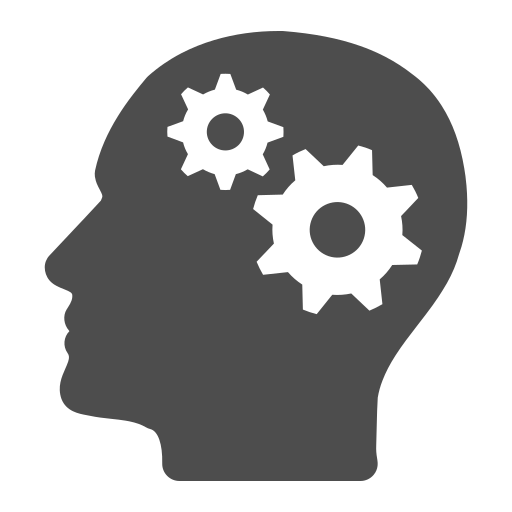 Memorize unit A-B for no more than 5 minutes. Note: there is nothing magical about 5 minutes. It can be one minute, three minutes, whatever.
Memorize unit A-B for no more than 5 minutes. Note: there is nothing magical about 5 minutes. It can be one minute, three minutes, whatever.
-
 Memorize another unit C-D for no more than 5 minutes.
Memorize another unit C-D for no more than 5 minutes.
-
 Play unit A-B from memory. Try to get it on the first try and move on.
Play unit A-B from memory. Try to get it on the first try and move on.
-
 Memorize unit E-F.
Memorize unit E-F.
-
 Play unit C-D by memory. Try to get it on the first try and move on.
Play unit C-D by memory. Try to get it on the first try and move on.
-
 Play unit A-B from memory. Try to get it on the first try and move on.
Play unit A-B from memory. Try to get it on the first try and move on.
Keep randomizing. Don't fall into any pattern. The goal is to be able to play any of the units from memory on the first try and then move on to another unit.
Here are two more ideas and approaches to random practice:
- Do not always start at the beginning. When playing from memory, do not always start at the beginning of the piece or the beginning of a section. Start from various spots throughout the piece to ensure you can start anywhere. Close your eyes, point to a spot in the score, and start playing/memorizing from there. Should you ever have a memory slip, the ability to start anywhere in the piece will come to the rescue.
- Mix it up! Mix your work on memorizing a piece with practicing other pieces or exercises.
- Practice memorizing a spot in your piece.
- Stop and practice or play a different piece.
- After a few minutes, return to the piece you are memorizing and start at the spot you practiced a few minutes ago.
- Switch back to the other piece, an exercise, or a third piece. Practice that for a while.
- Return to the piece you are memorizing and start again at the spot you were memorizing earlier.
- Start by applying this strategy to one measure you are trying to memorize. As you memorize more of the piece, apply it to phrases, small sections, large sections, and finally, the entire piece.
- After playing another piece or exercise, the goal is to return to the spot you are memorizing and play it by memory on the first try.
See my technique tip for detailed information on random practice.
Another form of random practice is to work on your memorization several times throughout the day. Spacing out your memorization practice throughout the day forces retrieval from scratch without context or preparation, significantly improving long-term retention. Try cold play-throughs of the entire piece.
Yet another way some memory experts recommend practicing or testing retrieval is to write out the score from memory.
I AM HAVING A BAD DAY
Do not worry about having a "bad day." Some days, it will seem like you cannot remember anything or that you regressed. That is okay because it is an opportunity to rememorize the passages, which will strengthen your memorization. Here is why:
- Actively trying to recall information strengthens the neural pathways associated with that memory, making it more robust over time.
- The process of retrieving a memory requires deeper cognitive processing than simply reviewing it, leading to better long-term retention.
- Forgetting and then rememorizing helps identify the weak points in your memory. Addressing these weaknesses can produce a more solid and comprehensive understanding of the material.
- Correcting errors during rememorization reinforces the correct information, making it more likely to be retained accurately in the future.
- The process of forgetting and then relearning can create additional contextual cues that aid in future retrieval.
SIX ULTIMATE TESTS OF YOUR MEMORIZATION OF THE PIECE
PREREQUISITES:
- You listened to the piece dozens of times.
- You know the basic layout of the piece.
- You can sing the piece.
- You completed your visual-intellectual training and analysis of the piece, which gives you a repository of facts, connections, and relationships.
- You completed your auditory memory training.
- You completed your tactile or muscle memory training.
Whether you are memorizing one measure or trying to play through the entire piece by memory, use all six steps to imprint the music into your fingers and brain permanently. Although the goal is to do these tests at tempo, do not play so fast that you "outrun your memory." But don't play too slowly, or you will lose the thread of the music.
Do not do all six tests in one sitting. Space them out over several days or weeks.
-
 Play on the guitar at tempo, reading the music.
Play on the guitar at tempo, reading the music.
-
 Play in your head at tempo, reading the music.
Play in your head at tempo, reading the music.
- Feel and see your finger shapes and spacings on the fretboard.
- Feel what the right hand is playing.
- Hear the music in your head.
- Note the intellectual facts and relationships you have already learned.
-
 Play on the guitar at tempo, watching your hands. Do not look at the music.
Play on the guitar at tempo, watching your hands. Do not look at the music.
- Anticipate the sound of what you are about to play.
- Anticipate the notes, chords, and finger shapes of what you are about to play.
- Anticipate the intellectual connections of what you are about to play.
-
 Play on the guitar at tempo, NOT looking at your hands (look into space or eyes closed), and not at the music.
Play on the guitar at tempo, NOT looking at your hands (look into space or eyes closed), and not at the music.
- See your fingers and the shapes/spacings on the fretboard.
- Feel what the right hand is playing.
- Anticipate the sound of what you are about to play.
- Note the intellectual connections of what you are about to play.
-
 Play in your head, NOT reading the music, but looking at the guitar fretboard. You may need to play slower for this test.
Play in your head, NOT reading the music, but looking at the guitar fretboard. You may need to play slower for this test.
- See your fingers and the shapes/spacings on the fretboard.
- Know what your right hand is playing.
- Anticipate the sound of what you are about to play.
- Anticipate the notes, chords, and finger shapes you are about to play.
- Note the intellectual connections of what you are about to play.
-
 Play in your head, NOT reading the music and NOT looking at the fretboard. You may need to play slower for this test. You can close your eyes, stare into space, or stare at an object.
Play in your head, NOT reading the music and NOT looking at the fretboard. You may need to play slower for this test. You can close your eyes, stare into space, or stare at an object.
- Feel and see your finger shapes and spacings on the fretboard.
- Know what your right hand is playing.
- Hear the music in your head.
- Note the intellectual facts, connections, and relationships you have learned.
Once you can get through the entire piece in your head, try reviewing it last thing in the day and first thing in the morning before doing anything else. Studies show this seems to aid memory consolidation.
THE FINAL FRONTIER: PERFORMING FROM MEMORY
Refrain from using intellectual memory in performance.
Paradoxically, even though you will spend hours building the intellectual component of memorization, you should use it minimally in performance. Research shows that focusing on facts, relationships, patterns, and connections is essential to the PROCESS of memorization. However, when performing, overthinking each individual component of the music can get in the way of the automatic memory processes and cause memory failures.
Instead, allow your auditory and tactile or muscle memory to guide you while your intellectual memory works in the background. However, you can still call upon your intellectual memory at any time for critical cues. In other words, your intellectual memory should not dominate, but having a solid intellectual memory foundation can provide a safety net during unexpected moments of uncertainty. Remember, tactile or muscle memory alone is fragile without auditory and intellectual memory.
Focus on expression.
One of the most practical solutions to preventing memory slips is to think about expression, sound, phrasing, and musical structure (I am starting the second phrase, second section, here is the slow part, here is that sequence of fast scales, I am in the arpeggio section, I love this chord progression).
One of the most effective methods I use to prevent memory slips and to alleviate performance anxiety is to have a story I can play in my mind or a series of images I see as I perform the piece. You will find that the more concrete and detailed the story or pictures, the better your performance will be. The story and images prevent you from being distracted or fixated on details, allowing your auditory, tactile, and intellectual memory to work in harmony. See my technique tip for how the great cellist Yo-Yo Ma uses this technique in his performances.
Use simulations to test your memory.
It is difficult to simulate how well your memorization will stand up under the pressure of a live performance, but definitely try doing test performances for friends. Recording yourself (video or audio) can also be helpful because it "puts you on the spot." It adds discomfort, accountability, and self-awareness, similar to a live performance.
Use a technique called "Contextual Variability."
Testing your memorization in different contexts or states can make the memory more flexible and accessible in various situations, improving overall recall. Change the context or conditions of your practice sessions to make your memories more adaptable and robust.
- Change the location.
- Change the time of day.
- Change what you wear. Wear the clothes you will wear for the performance.
- Play in different chairs.
- Add distractions and take away distractions.
- Test in a small room, medium room, concert hall, or auditorium.
- Test in minimal lighting and intense lighting.
- To simulate a concert stage atmosphere, aim a work light at your chair in an empty space.
PERFORMANCE ANXIETY
Memorization and performance anxiety are connected. For some, the primary cause of performance anxiety is fear of memory lapses. Performance anxiety can wreak havoc on performing from memory. Therefore, it is important to find a way to reduce performance anxiety or stage fright. See my technique tip, How to Control Stage Fright (Performance Anxiety).
USE IT OR LOSE IT
Your ability to memorize improves the more you practice. However, once you have a piece thoroughly memorized, you don't need to play the piece every day to remember it. In fact, you can gradually space your memorization review or practice of the piece further and further apart with time. Once you have memorized your piece, here is a possible schedule to revisit or test your memorization:
- Review every day for one week.
- Review every other day for one week.
- Review twice a week for two weeks.
- Review once a week for three weeks.
- Review once a month.
- Review once every two months.
- Review once every three months.
Keep spacing the reviews further apart. Your memorization should "stick" if you only play the piece once or twice a year.
However, throughout the memory process and post-memorization, it is essential to occasionally play the piece READING THE MUSIC. I have had many students memorize their music and never look at the score again. When we review the piece a few weeks or months later and I point at a spot in the music and ask them to “Start here,” they have no idea where “here” is. The student’s ability to review and polish individual passages is severely handicapped. It is essential to maintain contact with the printed score so you can practice individual passages to keep a piece in tip-top condition.
DOWNLOAD THE PDF
Download the PDF here: How to Memorize Music: Comprehensive Guide for Lasting Memory
